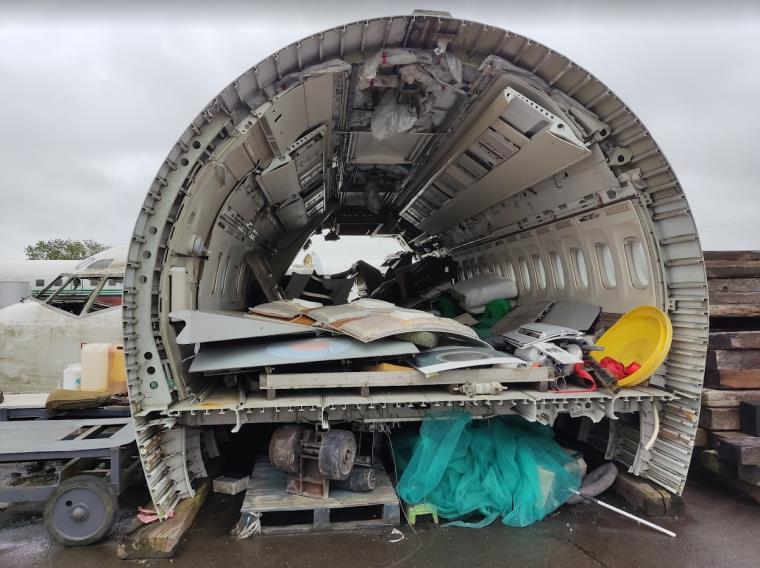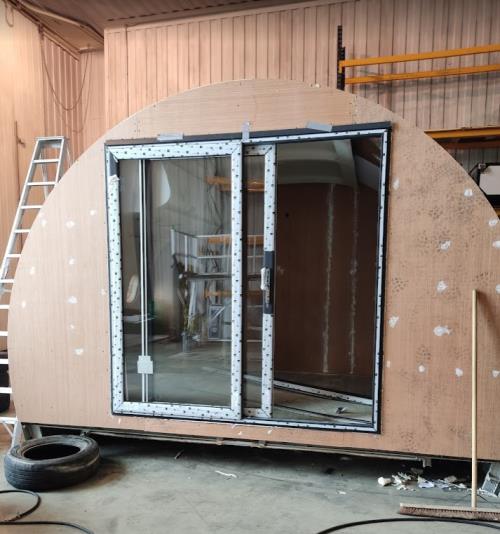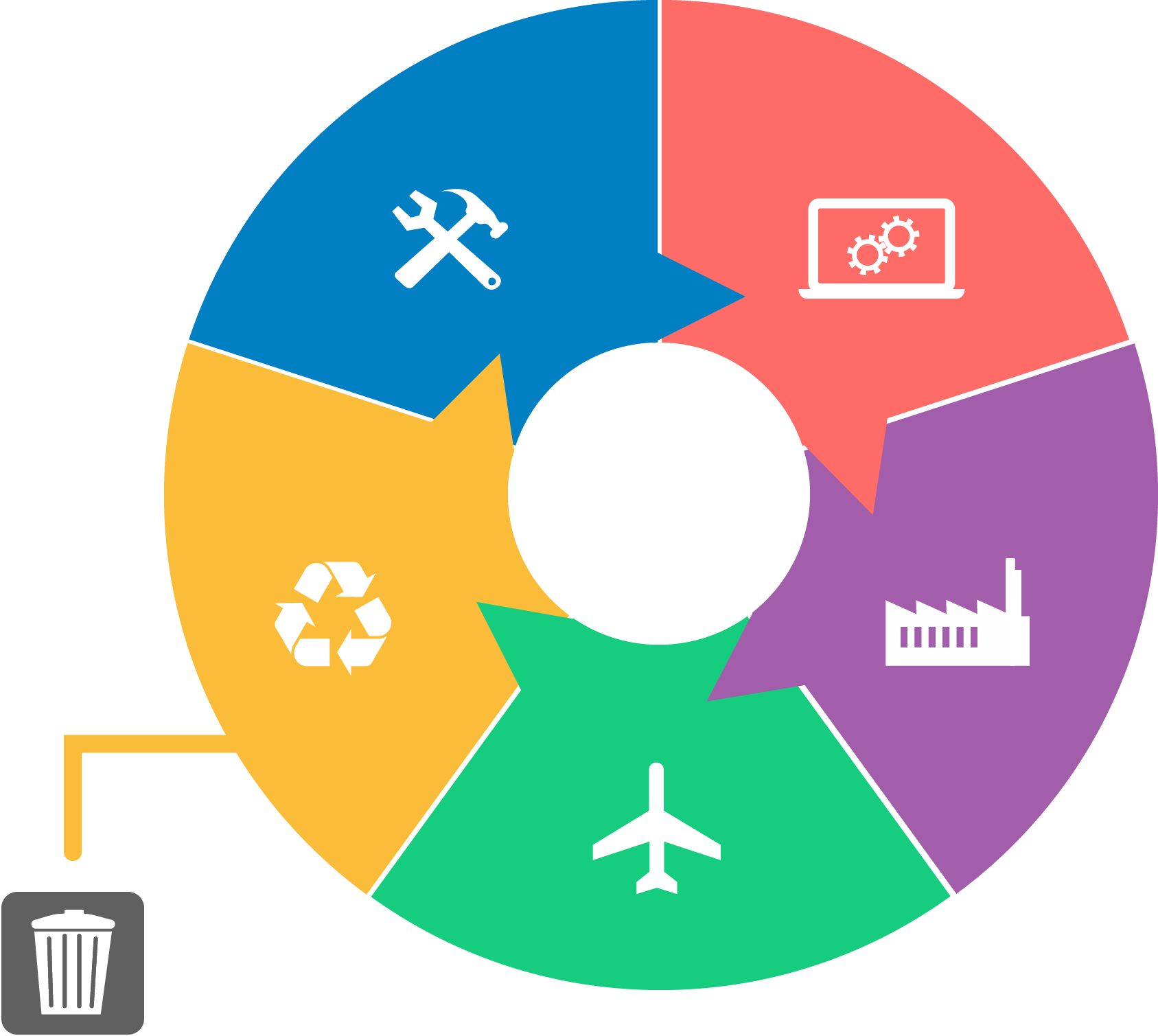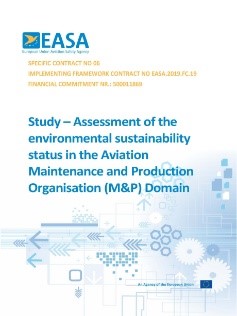When it comes to sustainability in aviation, there is a big focus on the operational phase of an airplane, that is, when the airplane is flying and taking passengers or cargo to their destinations. Indeed, this phase represents the biggest environmental impact, due to greenhouse gas emissions and the noise generated. But the production and the end-of-life phases also have an environmental impact – and so offer potential for improvements.
Because the end-of-life phase of an aircraft is a field that had not yet been studied in depth, EASA contracted a study on this topic. It resulted in the report Assessment of the environmental sustainability status in the Aviation Maintenance and Production Organisation Domain, published in 2023.
Why and when aircrafts are “retired”
 |
| Aircraft section under dismantling (Envisa, 2022) |
Aircraft are taken out of operation for two main motives: safety or economic reasons. The average age of retirement of aircraft is 25-30 years for passenger aircraft and 30-40 for freighters. Aircraft are considered waste once a final decommissioning decision is taken and the first cut is applied to the structure, meaning that they will not fly again.
Around the world, an average of 650 commercial aircraft were retired annually during the previous decade and more than 30% of the current fleet in Europe is expected to retire over the next decade. Therefore, making the most of a decommissioned aircraft also plays a role in aviation sustainability.
Life after retirement
After decommissioning, aircraft are disassembled and enter the so-called waste business, where materials are prepared to be recycled, upcycled, used for energy recovery or sent to landfill.
Reuse in aviation
Still serviceable aircraft components may be reused as spares for other aircraft, like engines, auxiliary power units, landing gears and other components. This reuse is influenced by the availability of the parts records, which determines the value of the part and the possibility to reincorporate it in the aerospace sector. To be reused, these equipment and parts need a valid approval.
Alternative use in non-air travel business
 |
| Aircraft cabin section undergoing a process to be reused as an office (Envisa, 2022) |
Alternative use refers to uses for different purpose from the one for which a part was conceived. When using aircraft components and sections for alternative use, the priority is to preserve the form and function, therefore preserving the value to the highest. Some examples of alternative reuse are:
- training and education;
- filmmaking, and TV productions;
- furniture;
- office areas;
- collectible items for aviation enthusiasts;
- use of parts in some other industries, for instance, the use engine turbine blades that can be integrated into land-based gas turbines.
When form and function cannot be kept, the focus is to preserve the material properties. Examples of keeping the material properties are:
- upcycling of aircraft aluminum and titanium;
- upcycling of tire rubbers;
- upcycling of valuable critical raw materials in jet engines.
Landfilling
A landfill area is a site for disposal of waste materials. According to the European Union (EU)'s waste hierarchy, landfilling is the least preferable option and should be limited to the necessary minimum. The good news: it has been proved that current aircraft that go through the end-of-life process can reach close to zero landfill.
Lack of specific guidelines for end-of-life of an aircraft
When road vehicles, like cars or trucks, reach their end of life, there are specific EU directives for waste management that target such vehicles. With aircraft, there is no specific regulation. When an aircraft reaches its end-of-life stage, it is considered an assembly of pieces of waste, and therefore is affected by the general legislations targeting waste depending on the materials used. For example, EU regulations affecting Waste Electrical and Electronic Equipment, Packaging and Packaging Waste, Chemicals, etc. affect aircraft parts as well. In addition, the EU Waste Framework Directive includes general elements of the Waste Management, such as the “polluter pays” principle and the waste hierarchy, which affect the waste management in aviation.
Eco-design: sustainability and circularity by design
There are currently no official requirements for the aviation industry to design new products considering the recovery of materials when aircraft are scrapped. Eco-design involves the integration of environmental considerations at all phases of the product lifecycle, including “design for decommissioning”.
| A characterisation of circular economy (Envisa, 2022) | |
|---|---|
 |
|
Including eco-design principles increases the sustainability of the aviation industry, by using more environmentally friendly materials and by making materials and parts easier to disassemble, reuse and recycle. Materials that have more difficulties to be recycled should be used less and less.

Further reading
Check the report Assessment of the environmental sustainability status in the Aviation Maintenance and Production Organisation Domain (available in English only) for more details on this topic, as well as several recommendations targeting a wide range of stakeholders.
